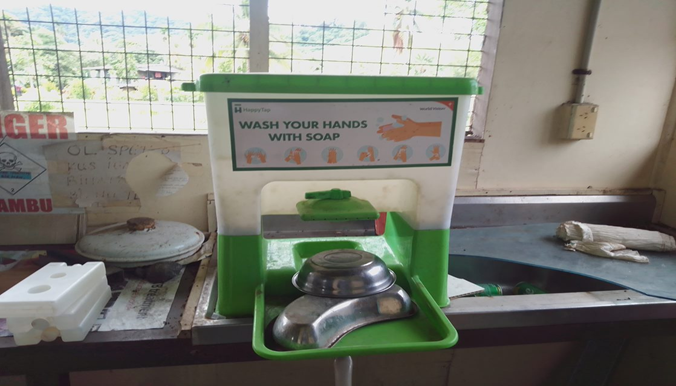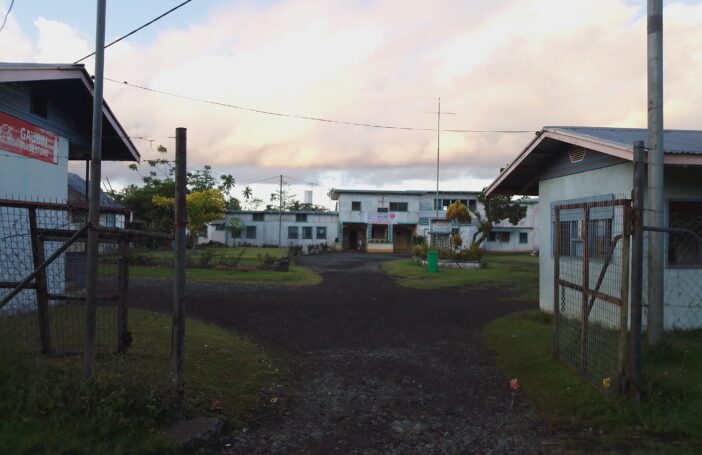Despite the availability of preventive tuberculosis (TB) medications, TB remains a critical public health challenge in Papua New Guinea. Although PNG is no longer one of the 30 countries with a high TB/HIV burden identified by WHO, a high burden of TB and multidrug-resistant TB remains. In 2011, the Department of Health introduced the National Tuberculosis Management Protocol (NTBMP), including TB infection prevention control (TB IPC) guidelines as a critical strategy to manage the high TB burden in the country. These TB IPC guidelines aim to interrupt the TB transmission cycle in healthcare institutions and prevent spread into the community. Though the guidelines have been promoted in the PNG health sector as a policy for over a decade, little information about the implementation of this policy is available to inform policymakers, health managers, and clinicians.
Research indicates that health facilities implementing optimum TB-IPC guidelines have effectively prevented TB transmission among susceptible individuals. For example, one successful strategy that highlights the efficacy of a TB IPC program in healthcare institutions was the implementation of a cough officer screening (COS) system in a hospital in Taiwan. This technique is an administrative control measure that trains nurses to promptly detect patients and guardians with coughs, and alert physicians. Through the operationalisation of the COS system, 184 – from a total of 7998 (2.3%) – “cough patients” were diagnosed with TB by the consulting physicians and were started on correct TB medications. This research suggests that without the COS system, these patients would have remained undiagnosed, endangering the lives of healthcare workers (HCWs), patients and guardians, and others in the broader community.
Despite the effectiveness of TB IPC, its implementation still needs to be improved in many healthcare institutions globally, particularly in low-income countries such as PNG. Our recent evaluation of the TB IPC guideline in district hospitals in the Highlands and Momase regions – using the WHO Infection Prevention Control Assessment Framework (IPCAF) – reveals that about 80% of the district hospitals in the study sample have either an inadequate or only basic level of TB IPC practice. This finding is consistent with studies in the Highlands region from a decade ago. According to WHO standards, health facilities with this status require significant improvement in TB IPC practice.
The picture that emerged from our analysis is one of relatively low priority for implementation in PNG’s healthcare sector coupled with a myriad of challenges in district hospitals. For example, although most rural hospitals have a TB IPC plan, no specific budget has been allocated to execute its activities. In addition, our study revealed chronic shortages of key HCWs in district hospitals, increasing workloads, and competing tasks for the limited staff. This has seriously paralysed TB-IPC activities, including patient triaging, cough education, screening, and community education.
Additionally, HCWs in district hospitals need more training on IPC practices. Currently, it appears that training opportunities that do exist are only accessible to TB program officers, leaving other key HCWs – including nurses, community health workers, and laboratory technicians – without this critical knowledge about TB IPC. Our evaluation in the Highlands and Momase regions also aligns with other reports that show a chronic shortage of essential medical supplies in rural health settings in other parts of PNG.
Worse still, about 50% (5 of 10) of the district hospitals have no designated TB wards. Our study revealed that patients diagnosed with positive and suspected TB cases were forced to be admitted with immunosuppressed patients with medical conditions in general medical wards. This phenomenon completely violates the recommended protocol of IPC standards, and endangers the health of other patients.
The recent COVID-19 pandemic has highlighted the significance of IPC measures in preventing healthcare-associated infections. However, rural health services – that serve more than 85% of the inhabitants in PNG – are under-resourced and lack good governance, leadership, and accountability at the Provincial Health Authority (PHA) level.
There is an urgent need to invest in strengthening interventions as articulated in the National Health Plan 2021-2030, such as: training and capacity building for HCWs; improvement in healthcare institutions’ infrastructure; consistent supply of protective technologies and drugs; maintenance of medical equipment; upgrading of rural laboratory settings; sufficient funding; adequate healthcare personnel; good governance and leadership; and availability of TB IPC guidelines at the PHA level and communicated to HCWs in rural health facilities. A robust health system and sound supporting infrastructure, including water and electricity, are essential facilitators of TB IPC practice in rural health settings.
It is imperative to note that if relevant stakeholders have not adequately supported the TB IPC policy over the past decade, there is no guarantee that other similar public health policies, such as the National Infection Prevention Control Policy, will be supported. There is, however, an opportunity to move TB IPC from the silo of national TB programs and embed it in the National Health Plan (in key result areas four and five, combating infectious diseases burden and health systems strengthening strategies).
Furthermore, TB IPC should be perceived as part of a comprehensive occupational health approach for promoting the wellbeing of HCWs as well as reducing the TB burden on the broader community.





Well done team. If this is the situation at district hospital level what would you conclude for health centres, aid posts and communities, many of whom are remote from a district hospital?
A former deputy secretary for health and architect of the national TB protocol, commented to me that PNG is short of about 60,000 HCW of all types to provide an adequate service across all levels.
But the National Department of Health and its provincial health authorities have insufficient funds to adequately support the skeleton staff levels or infrastructure they have now.
Even if a Fairy Godmother were to kick in the hundreds of millions needed annually to rebuild the capacity of the health system, how could the government financially support this structure going forward?
In my view there is a need to rethink what level of facilities government and provincial authorities should concentrate on coupled with an evolution in the way primary healthcare services are funded and delivered.
In a country of nine, or anyone’s best guess how many millions of people, a geographically challenging environment with wholly inadequate infrastructure, there is an urgent need to explore local solutions to local problems.
At present the communities that desperately need basic services are passive onlookers to whatever the government can provide. For many that means nothing at all.
In my experience there is no reason why the people who want the services cannot become part of the solution. To do this they must be empowered economically and some of the output directed towards providing the outreach and “community-based” services they require. Women, who are the primary caregivers have a major part to play in this vision.
While this may sound like pie in the sky, the economic component to underpin this has been successfully and sustainably demonstrated in remote settings throughout PNG.
If primary healthcare indicators around TB, malaria, maternal and child health, immunisation and referral are to be improved the time has come to give end users agency over the outcomes they desire.
This requires a broader vision with a multi-sectoral approach of which health service delivery is an outcome component.
In partnership with district and local level government health authorities, make them part of the solution or risk being locked into a system that is unlikely to ever have the resources to solve the nations health challenges alone.
Hi Stephen,
Thank you so much for your valid comments.
The rural health services that serve the bulk of the inhabitants lack the capacity to deliver optimum healthcare to the rural population. The primary healthcare settings including, health centres, sub-health centres, community health posts, and aid posts, are struggling to deliver basic health services. There are constant reports of a long-term shortage of essential healthcare workers in all tiers of healthcare settings. Health centres run out of basic medications frequently.
Fundings earmarked for the delivery of rural health services simply do not seem to reach the facilities which are responsible for translating health policy through public health programs. There are reports indicating that funding for the health sector has dramatically increased over the past decades. Despite these increases, rural health facilities are struggling to cover the cost of many of their operational activities. Also, the overall health indicators have not improved with the given funding. The shortage of funding has affected other recurrent programs. That suggests that there is a need to seriously reconsider how the funds are disbursed to the province and to facilities. The national health department should revisit the 5th National Health Plan strategy to transfer funds directly to health facilities rather than provinces. From my experience working in health services management with the Lutheran Health Services for 16 years, this approach works fairly well-provided health managers, the officer in charge and facility administrators are adequately trained with health management skills.
The basic healthcare infrastructure, including inpatient wards and diagnostic facilities, is poorly maintained. We can’t emphasise enough that there is a need for good leadership, management, and accountability at all tiers of the healthcare system including, the local level administration, district health services and provincial health authority.
There is a need to strengthen the capacity of the rural health services. The government should concentrate on improving the district hospitals, health centres, community health posts and aid-post. There is also a need to refocus the model of healthcare from an institutional-based to a community/population-based approach by engaging more population health programs, maternal and child health, health promotion and education through the healthy island concept and addressing the social determinants of health (SDOH), such as water, hygiene and sanitation (WASH), housing, access to primary healthcare, and income earning opportunities. More investments are needed in these areas. The majority of the rural populace in PNG access primary healthcare via public health programs. Therefore, if the government can decentralise health services via primary healthcare services, we can witness improved health indicators over the years.